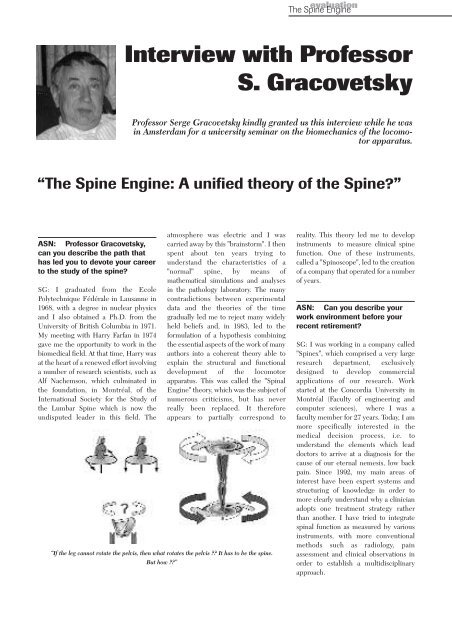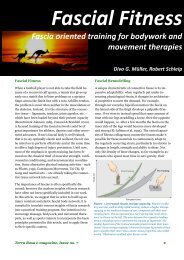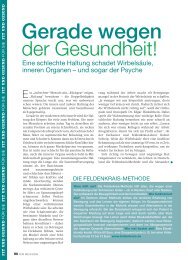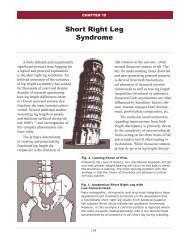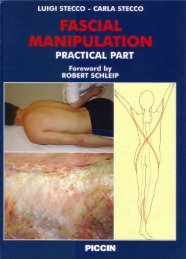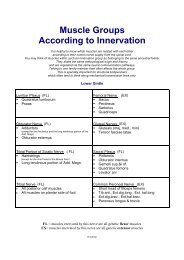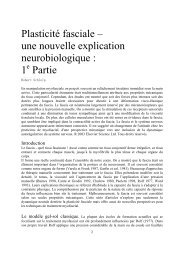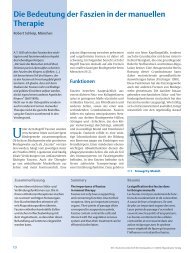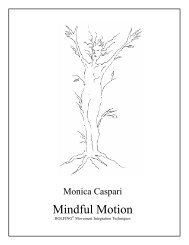The Spine Engine - Alexander Technique Running
The Spine Engine - Alexander Technique Running
The Spine Engine - Alexander Technique Running
You also want an ePaper? Increase the reach of your titles
YUMPU automatically turns print PDFs into web optimized ePapers that Google loves.
evaluation<br />
<strong>The</strong> <strong>Spine</strong> <strong>Engine</strong><br />
Interview with Professor<br />
S. Gracovetsky<br />
Professor Serge Gracovetsky kindly granted us this interview while he was<br />
in Amsterdam for a university seminar on the biomechanics of the locomotor<br />
apparatus.<br />
“<strong>The</strong> <strong>Spine</strong> <strong>Engine</strong>: A unified theory of the <strong>Spine</strong>?”<br />
ASN: Professor Gracovetsky,<br />
can you describe the path that<br />
has led you to devote your career<br />
to the study of the spine?<br />
SG: I graduated from the Ecole<br />
Polytechnique Fédérale in Lausanne in<br />
1968, with a degree in nuclear physics<br />
and I also obtained a Ph.D. from the<br />
University of British Columbia in 1971.<br />
My meeting with Harry Farfan in 1974<br />
gave me the opportunity to work in the<br />
biomedical field. At that time, Harry was<br />
at the heart of a renewed effort involving<br />
a number of research scientists, such as<br />
Alf Nachemson, which culminated in<br />
the foundation, in Montréal, of the<br />
International Society for the Study of<br />
the Lumbar <strong>Spine</strong> which is now the<br />
undisputed leader in this field. <strong>The</strong><br />
atmosphere was electric and I was<br />
carried away by this "brainstorm". I then<br />
spent about ten years trying to<br />
understand the characteristics of a<br />
"normal" spine, by means of<br />
mathematical simulations and analyses<br />
in the pathology laboratory. <strong>The</strong> many<br />
contradictions between experimental<br />
data and the theories of the time<br />
gradually led me to reject many widely<br />
held beliefs and, in 1983, led to the<br />
formulation of a hypothesis combining<br />
the essential aspects of the work of many<br />
authors into a coherent theory able to<br />
explain the structural and functional<br />
development of the locomotor<br />
apparatus. This was called the "Spinal<br />
<strong>Engine</strong>" theory, which was the subject of<br />
numerous criticisms, but has never<br />
really been replaced. It therefore<br />
appears to partially correspond to<br />
“If the leg cannot rotate the pelvis, then what rotates the pelvis ?? It has to be the spine.<br />
But how ??”<br />
reality. This theory led me to develop<br />
instruments to measure clinical spine<br />
function. One of these instruments,<br />
called a "Spinoscope", led to the creation<br />
of a company that operated for a number<br />
of years.<br />
ASN: Can you describe your<br />
work environment before your<br />
recent retirement?<br />
SG: I was working in a company called<br />
"<strong>Spine</strong>x", which comprised a very large<br />
research department, exclusively<br />
designed to develop commercial<br />
applications of our research. Work<br />
started at the Concordia University in<br />
Montréal (Faculty of engineering and<br />
computer sciences), where I was a<br />
faculty member for 27 years. Today, I am<br />
more specifically interested in the<br />
medical decision process, i.e. to<br />
understand the elements which lead<br />
doctors to arrive at a diagnosis for the<br />
cause of our eternal nemesis, low back<br />
pain. Since 1992, my main areas of<br />
interest have been expert systems and<br />
structuring of knowledge in order to<br />
more clearly understand why a clinician<br />
adopts one treatment strategy rather<br />
than another. I have tried to integrate<br />
spinal function as measured by various<br />
instruments, with more conventional<br />
methods such as radiology, pain<br />
assessment and clinical observations in<br />
order to establish a multidisciplinary<br />
approach.
ASN: You mentioned<br />
Professors Farfan and<br />
Nachemson with whom you<br />
worked. In what context did you<br />
conduct these collaborations?<br />
SG: My collaboration with Harry Farfan<br />
involved 7 to 8 hours a week and lasted<br />
approximately from 1974 to 1985. We<br />
conducted a large number of studies and<br />
published many papers together. Harry<br />
had exceptional intuition and vision,<br />
extending well beyond conventional<br />
medicine. He believed that spinal<br />
problems were due to excess mechanical<br />
torsion. Nachemson, an impulsive and<br />
brilliant man, saw most spinal problems<br />
in terms of disk compression. When<br />
Farfan and Nachemson were on the<br />
same podium at any congress organized<br />
anywhere on the planet, you could be<br />
sure of a fierce, and well-reasoned,<br />
battle of wits. My own work was greatly<br />
influenced by the jousting between<br />
these two exceptional personalities. <strong>The</strong><br />
spinal engine theory actually represents<br />
a compromise between these two<br />
extreme points of view supported by<br />
Farfan and Nachemson. This theory<br />
demonstrates the irreducible link<br />
between compression and torsion<br />
phenomena which are an integral part of<br />
the principle of human locomotion.<br />
ASN: What are the general<br />
principles of your Spinal <strong>Engine</strong><br />
theory?<br />
SG: <strong>The</strong> main idea is that locomotion is<br />
an activity which takes precedence to all<br />
other activities. <strong>The</strong> individuals of a<br />
species must move in order to survive<br />
and enjoy vital bodily freedom.<br />
However, we need to define certain<br />
limits to this hypothesis. According to<br />
this theory, the animal must travel from<br />
point A to point B by consuming a<br />
minimum of energy, in a constant<br />
«Are the legs really<br />
necessary ???»<br />
gravitational field, with, as a corollary,<br />
that while walking, the various<br />
structures (bone, ligaments and muscles)<br />
must be submitted to a minimum of<br />
stress. Anatomy therefore emerges as<br />
the solution and not the given parameter<br />
of the problem.<br />
All of the possible solutions to this<br />
problem have led to many anatomic<br />
configurations, and our anatomy is only<br />
one expression of these numerous<br />
possibilities. <strong>The</strong> human body as we<br />
know it today, is mainly the consequence<br />
of the need to effectively walk on two<br />
feet in a constant gravitational field. <strong>The</strong><br />
spinal engine oscillates within this<br />
gravitational field.<br />
ASN: What, then,is the role of the<br />
spine in the locomotion?<br />
SG: I consider the spine to be the<br />
"primary" engine, in the etymological<br />
Compression<br />
sense of the word. This primary engine,<br />
so obvious in our ancestors the fish, has<br />
not travelled towards the lower limbs<br />
over time, although its role has become<br />
more obscure and may appear to be<br />
secondary to the role of the lower limbs.<br />
However, this logic is faulty, as we are<br />
able to "walk" on our knees with<br />
relatively little adaptation, which<br />
demonstrates that our legs are not truly<br />
essential to human locomotion. A<br />
wooden leg is just as effective. It would<br />
be conceivable to cut the femur one<br />
centimeter above the knee without<br />
significantly affecting walking. This<br />
therefore raises the question: how far<br />
can we cut the femur before affecting<br />
human locomotion. <strong>The</strong> answer is that<br />
the lower extremity can be completely<br />
removed without interfering with the<br />
primary movement of the pelvis. This<br />
statement may appear somewhat<br />
excessive, but it is supported by the<br />
facts.<br />
Torsion<br />
“Pathology gives data on how the spine is used<br />
in life. Any explanation for human gait must<br />
incorporate these pathological findings.”
Prof. Gracovetsky then showed<br />
us a film on his computer,<br />
representing a man with no legs<br />
and no stumps walking by<br />
successively advancing his<br />
ischial tuberosities, as if he had<br />
legs. <strong>The</strong> spinal mechanics then<br />
appeared to be the engine of this<br />
locomotion, which appeared to<br />
so closely resemble normal<br />
walking.<br />
It is obviously preferable to have legs,<br />
but they only amplify the movements of<br />
the pelvis, and their functional role<br />
remains secondary.<br />
ASN: Can you briefly describe<br />
the interrelations between the<br />
spine, the pelvis and the lower<br />
limbs?<br />
SG: <strong>The</strong> spinal engine is quite obvious<br />
in the case of a snake or a lizard, but<br />
when a high level of power needs to be<br />
developed, the muscles of the trunk are<br />
insufficient. To increase the volume of<br />
energy-generating muscles, they had to<br />
be displaced outside of the abdominal<br />
cavity, to the legs. <strong>The</strong> first role of the<br />
legs is to support the energy sources,<br />
which enable us to move at high speeds.<br />
However, rotation of the pelvis (as the<br />
pelvis rotates around a vertical axis<br />
when we walk) with muscles which<br />
draw the pelvis downwards leads to a<br />
problem of efficacy. This problem is<br />
resolved by using the earth's<br />
gravitational field as the site of<br />
intermediate storage, in which the<br />
muscle energy released by the legs with<br />
each step is temporarily stored and then<br />
recovered during the monopodal stance<br />
phase. This energy impulse then<br />
ascends up the leg and is filtered by the<br />
leg, so that it reaches the vertebral<br />
column with the appropriate phase and<br />
amplitude. <strong>The</strong> spine can therefore use<br />
this energy to mobilize each<br />
intervertebral joint, and to rotate each<br />
vertebra and the pelvis in an appropriate<br />
fashion. Movement of the vertebral<br />
" Only half the available muscle power is used. Each step<br />
advances the animal by one shoulder width "<br />
column, especially its axial rotation<br />
movement, is therefore derived from the<br />
hip extensor muscles.<br />
ASN: What happens in the static<br />
position?<br />
SG: <strong>The</strong> anatomic structures which<br />
connect the spine to the lower limbs are<br />
considerable. Take biceps femoris or the<br />
hamstrings, for example; the force<br />
generated by the hamstrings are<br />
channelled by the sacrotuberous<br />
ligament, which controls longissimus<br />
lumborum and latissimus lumborum<br />
situated on either side of the lumbar<br />
spine. Part of the sacrotuberous<br />
ligament then controls the iliocostalis<br />
thoracis muscle up to the superior part<br />
of the thoracic spine. Two transverse<br />
planes (the right hamstrings control part<br />
of the muscles connected to the left side<br />
of the thorax and vice versa) constitute<br />
another direct link between the<br />
hamstrings and the superior part of the<br />
thoracic spine. Another important<br />
linking element consists of gluteus<br />
maximus which crosses the medial<br />
aspect of the spine to be attached to<br />
latissimus dorsi, which controls arm<br />
movements. All of these connections<br />
form a sort of cross-pyramid of the back,<br />
which ensures very strong mechanical<br />
integrity from the upper limbs to the<br />
lower limbs.<br />
ASN: Can you place the<br />
configuration of the human<br />
locomotor apparatus, as we<br />
know it, in the context of<br />
evolution?<br />
SG: <strong>The</strong> presumed starting point (as it is<br />
only a hypothesis) is that primitive fish,<br />
450 million years ago, moved in the<br />
same way as modern fish, i.e. by a lateral<br />
inflection movement of the spine. Fish<br />
which subsequently ventured onto dry<br />
land were faced with several problems,<br />
the first being to move by planting their<br />
fins into the mud by means of an<br />
alternating movement. This axial<br />
rotation movement combined with the<br />
lateral flexion movement resulted in the<br />
movements of flexion and extension.<br />
Thus, the simple need to move over<br />
small pebbles led our fish to invent<br />
flexion and extension movements. This<br />
same flexion-extension movement<br />
subsequently allowed galloping and the<br />
development of the lower limbs, as the<br />
para-axial muscles gradually moved<br />
outside of the abdominal cavity to<br />
become hamstring muscles, in order to<br />
increase the brute power available for<br />
locomotion. Some of these vertebrates<br />
subsequently returned to the sea, while<br />
retaining their capacities for flexionextension<br />
movements acquired during<br />
their "stay" on dry land. <strong>The</strong>se animals<br />
are marine mammals, which also<br />
breathe in a very different way from fish.<br />
<strong>The</strong> hypothesis that these marine<br />
mammals are descendants of terrestrial
“Solution: Change locomotor design to advance by one body length at each step”<br />
“Lordosis is a unique feature of the human<br />
spine”<br />
mammals are descendants of terrestrial<br />
quadrupeds, at their turn descended<br />
from marine animals is now generally<br />
accepted.<br />
<strong>The</strong> inevitable increase in the muscle<br />
mass of the legs then made an upright<br />
posture possible. Finally, the need to<br />
advance and therefore to pivot the pelvis<br />
in two alternating ways, gave rise to the<br />
spinal mechanics that we now know<br />
today.<br />
ASN: When we listen to you<br />
speak, we have the impression<br />
that you are neither a doctor, nor<br />
a biomechanical engineer. How<br />
would you describe yourself?<br />
SG: I have never thought about it, but I<br />
am certainly proud to have contributed<br />
to solving certain problems. <strong>The</strong><br />
solutions that I proposed were the<br />
subject of a great many criticisms,<br />
sometimes more destructive than<br />
constructive, but in the final analysis,<br />
“Lateral bending with lordosis induces an<br />
axial torque”<br />
the need to reply to these criticisms was<br />
a major element that helped me to<br />
present my ideas more rigorously. It is<br />
true that I sometimes felt that certain<br />
criticisms did not always reflect a<br />
disagreement based on good faith, and I<br />
sometimes answered in a way that I now<br />
regret.<br />
ASN: Don't you think that your<br />
theory was the subject of so<br />
much criticism because you did<br />
not belong to any clearly<br />
identified discipline?<br />
SG: I was not trying to solve the<br />
problem of human locomotion. Many<br />
other scientists more erudite than<br />
myself possessed the necessary<br />
elements to converge on this vision of<br />
the spinal engine. Lowett in 1898 (a<br />
century ago!) came close to this solution,<br />
but did not take the last step, as it<br />
appeared far too incongruous. I can also<br />
think of people like Farfan, Nachemson,<br />
Pope, Winter and many others. All in all,<br />
it wasn't my place to find this solution,<br />
but rather all these other people who<br />
had infinitely more knowledge and<br />
experience in relation to the spine. I felt<br />
a need and I saw a gap in the logic of<br />
our knowledge at the time. I was very<br />
young when I entered this field (I was<br />
appointed Professor at Concordia<br />
University in Montréal in 1970), with a<br />
certain independence of mind, and I<br />
started by studying everything that my<br />
predecessors had done. It took me 3<br />
years to review thousands of<br />
publications on the subject, which I<br />
refined to 600 or 700 papers that I<br />
considered to be important. <strong>The</strong>re were<br />
papers all over my office: on the floor, in<br />
cabinets. I was therefore faced with<br />
strong and often divergent opinions<br />
voiced by honest people and I asked<br />
myself how I could incorporate all of<br />
these diverging views into an allencompassing<br />
theory, a sort of unifying<br />
theory, as is often the case in physics.<br />
<strong>The</strong>n, one day in January 1983, I<br />
suddenly had a vision : I saw the spine<br />
walking, a sort of slow-motion film. I<br />
then had to formulate this vision into a<br />
theory which was mathematically sound<br />
and publish it, which I did for the first<br />
time in 1985.<br />
ASN: What are your current<br />
projects?<br />
SG: I made a lot of errors in the way in<br />
which systems for the diagnosis of spinal<br />
diseases should be designed. I fought for<br />
many years to promote the use of a<br />
measurement platform, which can be<br />
greatly improved. When I started, about<br />
twenty years ago, computers were very<br />
slow, and measurement systems were<br />
relatively inefficient. Currently available<br />
solutions will inevitably integrate digital<br />
imaging, slightly more advanced tools<br />
for the assessment of pain, some of the<br />
patient's psychological aspects, and<br />
function. This should provide a more<br />
accurate description of the patient,<br />
which will obviously not be perfect, but
“<strong>The</strong> leg transfers the heel strike energy to<br />
the spine. It is a mechanical filter.<br />
<strong>The</strong> knee is a critical part of that filter<br />
Improper energy transfer will affect spinal<br />
motion<br />
Functional assessment of the spine ought to be<br />
part of the assessment of knee surgery”<br />
Contact<br />
Information:<br />
Serge Gracovetsky<br />
gracovetsky@videotron.ca<br />
209 Dauphine<br />
St Lambert QC<br />
Canada J4S 1N3<br />
which, in any case, would be better than<br />
the system available at the present time.<br />
<strong>The</strong> decision to perform surgery and<br />
evaluation of its impact on all of the<br />
locomotor apparatus are essential, and I<br />
am going to continue to patent several<br />
ideas and continue in this direction.<br />
Interview by A. Templier<br />
Serge Gracovetsky wishes<br />
to acknowledge the<br />
considerable contribution<br />
made by numerous<br />
individuals: N Newman,<br />
M Richards, S Asselin,<br />
V. Vidovic, ...<br />
ASN: ARGOS is above all a<br />
network of orthopaedic surgeons<br />
and neurosurgeons. Do you have<br />
a special message for our<br />
members and readers?<br />
SG: <strong>The</strong> diagnosis of spinal diseases,<br />
especially low back pain, is problematic<br />
in at least 90% of cases. Nevertheless,<br />
the current healthcare system expects<br />
the doctor to find a permanent solution<br />
to an insoluble problem. Health<br />
authorities need to recognize that low<br />
back pain is a difficult condition to<br />
diagnose, and provide appropriate<br />
resources to help the medical<br />
profession. In my opinion, fees for<br />
medical procedures concerning low<br />
back pain should be considerably<br />
increased so that the doctor can spend<br />
the necessary time to establish the<br />
preoperative and postoperative<br />
diagnoses using appropriate tools, while<br />
maintaining the same level of income. ■<br />
“<strong>The</strong> spine is an engine driving the pelvis<br />
Human anatomy is a consequence of function.<br />
<strong>The</strong> knee cannot be tested in isolation.<br />
It is part of the overall function and purpose<br />
of the musculoskeletal system”


